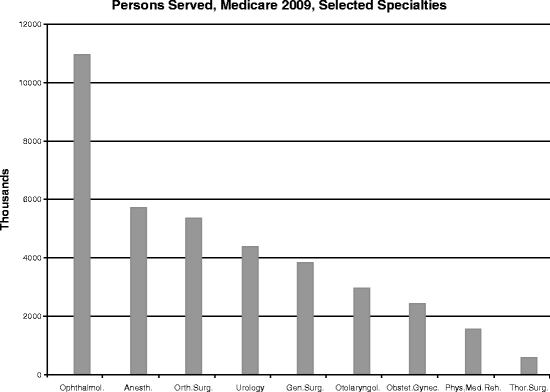Specialty
Percent
Cardiovascular
58.4
Ophthalmology
48.5
Urology
47.9
Gen’l Int’l Med
42.7
Gen’l Surgery
35.8
Neurology
28.6
Dermatology
28.1
Family Practice
25.9
Orthopedic
25
Otolaryngology
22.5
Psychiatry
9.9
OB/GYN
7.1

Fig. 1.1
Number of persons served by selected surgical and related specialties in the year 2009

Fig. 1.2
In-hospital surgical procedures in rate per 10,000 persons, for selected surgical specialties. Note that urology and ophthalmology appear to have low rates. However, many of their procedures are performed in office or ambulatory facilities
Table 1.2
Most Common eight geriatric/Medicare diagnoses
Diagnosis | Percent, age 65+ |
|---|---|
Hypertension | 53 |
Arthritis | 49.6 |
Heart disease | 31 |
Diabetes | 18.1 |
Sinusitis | 13.8 |
Ulcer | 10.8 |
Asthma | 10.6 |
Prostate cancer | 10.2 |
Your elderly urologic patients merit special assessment on several fronts. Many nonoperative urologic conditions, such as lower urinary tract symptoms, require treatment with medications that can affect cognition and/or interact with other daily medications [1]. Urinary afflictions such as frequency, urgency, and incontinence contribute to non-urologic morbidity because of requirement for movement and result in falls. The need to arise at night for voiding (nocturia) also leads to increased risk of falls in the darkened environment. Older patients’ needs differ because processes of aging make them different from those younger than 65 years. Why? Because the physiology of aging generates changes that cause the elderly to have less physiological strength in many organ systems. Perhaps one of the best illustrations of these changes is summarized in Fig. 1.3 [2]. Note that renal function decreases to 60% of normal by age 80, cardiac function by 30% and pulmonary function by 50–60%. Some geriatricians term this loss of reserve function in body systems as “homeostenosis” or lack of ability to respond adequately to external stresses, versus the usual beneficial response of “homeostasis”[3]. It is this inability to respond to stress that causes the increased risk levels that one tries to include in various co-morbidity classifications. And in addition to consideration of the usual disease conditions that one considers dangerous (hypertension, cardiovascular disease, pulmonary disease, diabetes, etc), there are a number of additional topics that pertain to the aged patient, termed “geriatric syndromes” (Table 1.3) [4].






Fig. 1.3
Graphic depiction of deterioration of various body systems as one ages
< div class='tao-gold-member'>
Only gold members can continue reading. Log In or Register to continue
Stay updated, free articles. Join our Telegram channel

Full access? Get Clinical Tree







